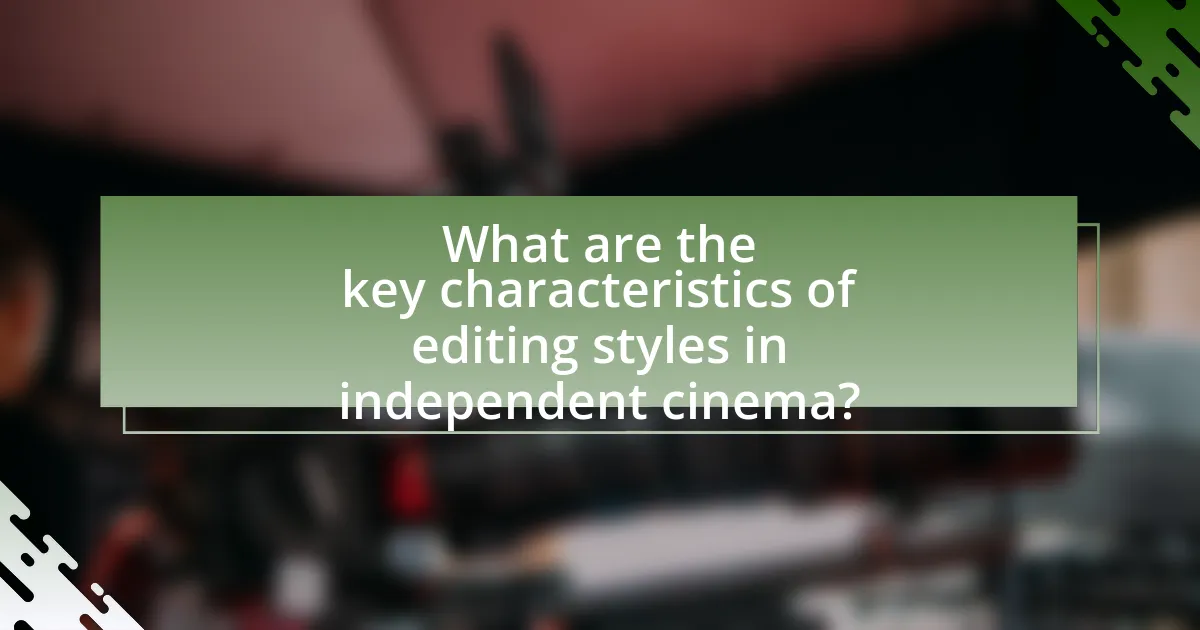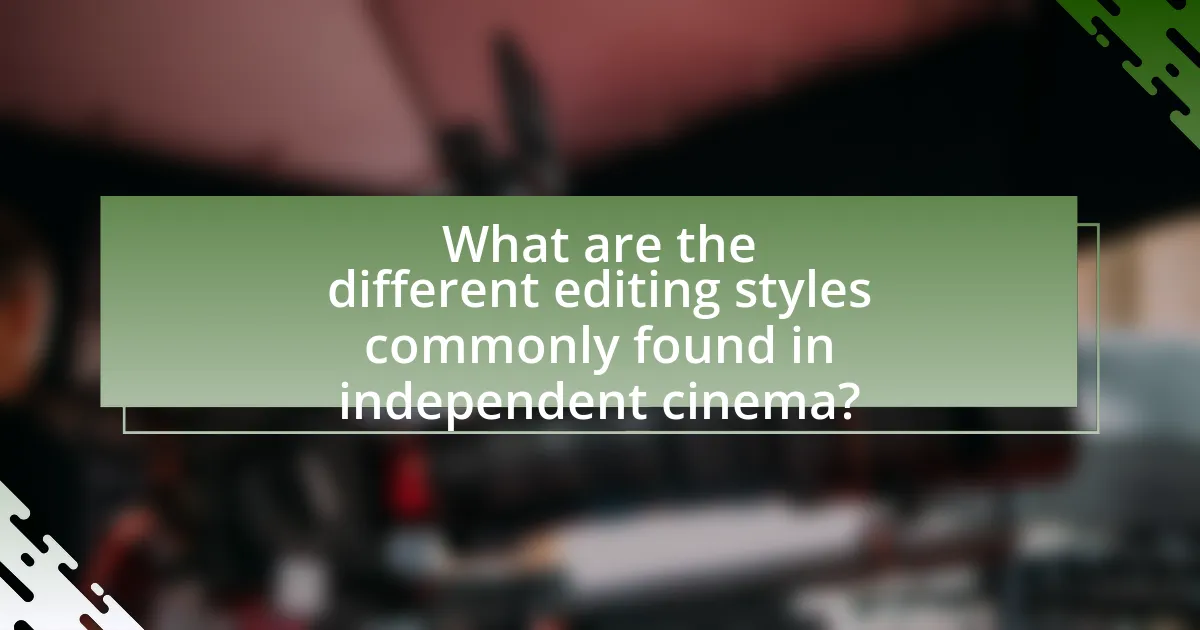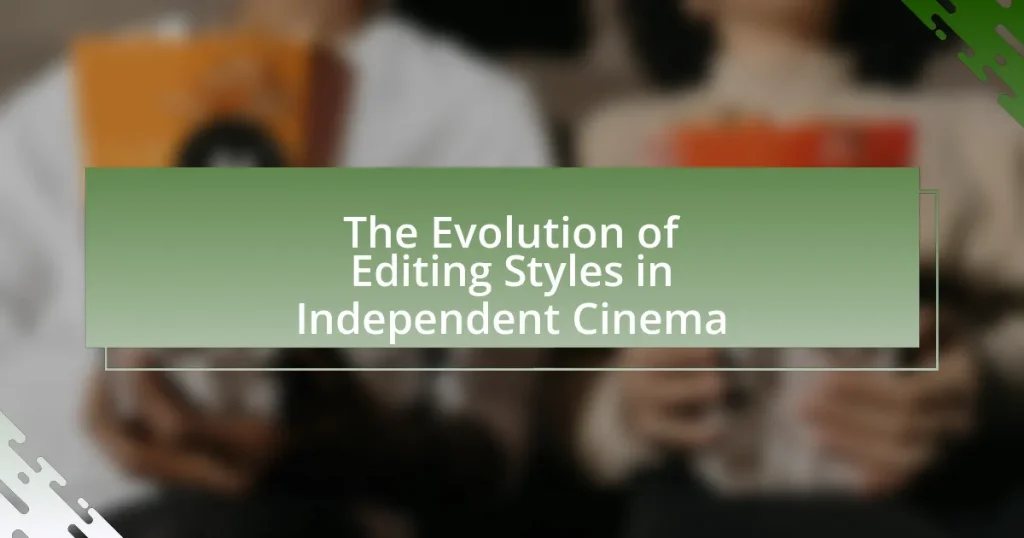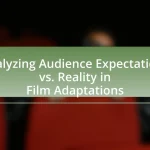The article examines the evolution of editing styles in independent cinema, highlighting key characteristics such as non-linear narratives, minimalistic techniques, and a focus on character-driven storytelling. It discusses how editing styles have transformed over the decades, influenced by historical events and technological advancements, and how these changes reflect cultural narratives and regional filmmaking traditions. The article also explores the emotional impact of various editing techniques, the role of editing in conveying social messages, and best practices for independent filmmakers to enhance their storytelling through effective editing choices.

What are the key characteristics of editing styles in independent cinema?
The key characteristics of editing styles in independent cinema include non-linear narratives, minimalistic techniques, and a focus on character-driven storytelling. Independent films often employ non-linear editing to create a fragmented narrative structure, allowing for a more personal and subjective experience. Minimalistic editing techniques, such as jump cuts and long takes, are frequently used to maintain an authentic and raw aesthetic, reflecting the film’s budget constraints and artistic vision. Additionally, the emphasis on character-driven storytelling often leads to editing choices that prioritize emotional resonance over conventional pacing, enhancing the viewer’s connection to the characters and their journeys. These characteristics are evident in films like “The Blair Witch Project,” which utilized simple editing to amplify tension, and “Frances Ha,” which employed a mix of traditional and experimental editing to convey the protagonist’s emotional state.
How have editing styles evolved over the decades in independent cinema?
Editing styles in independent cinema have evolved significantly from the 1960s to the present, reflecting changes in technology, audience expectations, and narrative techniques. In the 1960s and 1970s, independent films often employed a more experimental and non-linear editing style, influenced by the French New Wave, which favored jump cuts and a fragmented narrative structure. By the 1980s and 1990s, editing became more polished, with a focus on narrative coherence and emotional pacing, as seen in films like “The Blair Witch Project,” which utilized handheld camera work and rapid cuts to create tension.
In the 2000s and beyond, digital editing technology allowed for greater flexibility and creativity, leading to innovative techniques such as seamless transitions and the integration of visual effects, as exemplified in films like “Eternal Sunshine of the Spotless Mind.” The rise of streaming platforms has also influenced editing styles, with shorter, more dynamic cuts becoming prevalent to cater to the fast-paced consumption habits of audiences. Overall, the evolution of editing styles in independent cinema reflects a continuous adaptation to technological advancements and shifting cultural narratives.
What historical events influenced changes in editing styles?
The rise of independent cinema has been significantly influenced by historical events such as the emergence of the French New Wave in the late 1950s, which introduced innovative editing techniques like jump cuts and non-linear storytelling. This movement challenged traditional cinematic norms and inspired filmmakers to experiment with editing styles, leading to a more personal and artistic approach in independent films. Additionally, the digital revolution in the late 1990s and early 2000s democratized filmmaking, allowing for non-linear editing software to become widely accessible, further transforming editing practices. These events collectively shaped the evolution of editing styles in independent cinema, emphasizing creativity and individual expression.
How did technological advancements impact editing techniques?
Technological advancements significantly transformed editing techniques by introducing digital editing software, which streamlined the editing process and enhanced creative possibilities. The transition from analog to digital editing allowed filmmakers to manipulate footage with greater precision and efficiency, enabling techniques such as non-linear editing, which permits editors to access any part of the film without following a sequential order. This shift is evidenced by the widespread adoption of software like Avid Media Composer and Adobe Premiere Pro, which revolutionized the editing landscape in the late 20th and early 21st centuries. Additionally, advancements in hardware, such as faster computers and improved storage solutions, facilitated the handling of high-resolution video files, further expanding the scope of editing techniques available to independent filmmakers.
What role does editing play in storytelling within independent films?
Editing plays a crucial role in storytelling within independent films by shaping narrative structure, pacing, and emotional impact. In independent cinema, where budgets are often limited, editing becomes a vital tool for enhancing storytelling efficiency and clarity. For instance, the use of non-linear editing can create suspense or reveal character motivations in a more engaging way, as seen in films like “Memento,” which employs a fragmented narrative to immerse viewers in the protagonist’s disorientation. Additionally, editing techniques such as jump cuts or montages can convey complex themes succinctly, allowing filmmakers to express their vision without extensive resources. This strategic use of editing not only influences how stories are perceived but also reflects the unique artistic voice of independent filmmakers, making it an essential component of their storytelling process.
How does editing shape the narrative structure of independent films?
Editing shapes the narrative structure of independent films by determining the pacing, flow, and emotional impact of the story. Through techniques such as non-linear editing, jump cuts, and montage, independent filmmakers can manipulate time and space, allowing for a more subjective experience that reflects the characters’ inner thoughts and emotions. For instance, films like “Eternal Sunshine of the Spotless Mind” utilize fragmented editing to convey the disjointed nature of memory, enhancing the narrative’s exploration of love and loss. This approach not only engages the audience but also allows for innovative storytelling that distinguishes independent cinema from mainstream films.
What are the emotional effects of different editing styles on audiences?
Different editing styles evoke distinct emotional responses in audiences. For instance, rapid cuts can create a sense of urgency and excitement, often used in action sequences to heighten tension. Conversely, long takes can foster a feeling of intimacy and reflection, allowing viewers to engage deeply with characters and their emotions. Research by Bordwell and Thompson in “Film Art: An Introduction” highlights that editing rhythm significantly influences audience perception, with studies showing that faster editing can increase adrenaline levels, while slower editing can enhance emotional resonance. Thus, the choice of editing style directly impacts how audiences emotionally connect with the narrative and characters.

What are the different editing styles commonly found in independent cinema?
Independent cinema commonly employs editing styles such as nonlinear editing, jump cuts, and montage sequences. Nonlinear editing allows filmmakers to present events out of chronological order, creating a unique narrative structure that engages viewers differently. Jump cuts, which involve abrupt transitions between scenes, are often used to convey a sense of urgency or disorientation, reflecting the emotional state of characters. Montage sequences combine various shots to condense time and convey complex ideas quickly, often seen in films that aim to evoke strong emotional responses or highlight thematic elements. These editing techniques are prevalent in independent films due to their ability to challenge traditional storytelling methods and provide a more personal, artistic expression.
How do montage and continuity editing differ in independent films?
Montage and continuity editing differ significantly in independent films, primarily in their approach to narrative and visual storytelling. Montage editing emphasizes the juxtaposition of images to create meaning or evoke emotion, often using rapid cuts and non-linear sequences, which can enhance thematic depth or highlight contrasts. In contrast, continuity editing focuses on maintaining a seamless flow of action and spatial coherence, ensuring that the narrative progresses logically and smoothly, which is essential for viewer comprehension.
Independent films frequently utilize montage to convey complex ideas or emotional states, as seen in works like “Requiem for a Dream,” where rapid editing intensifies the film’s themes of addiction. Conversely, films such as “The Florida Project” employ continuity editing to ground the viewer in the characters’ experiences and everyday realities, allowing for a more immersive narrative. This distinction highlights how independent filmmakers often experiment with editing styles to serve their unique storytelling goals.
What are the unique features of montage editing in independent cinema?
Montage editing in independent cinema is characterized by its emphasis on juxtaposition and emotional resonance, allowing filmmakers to convey complex narratives and themes through the arrangement of disparate images. This technique often utilizes rapid cuts, non-linear storytelling, and a focus on visual symbolism to create a unique viewing experience that reflects the filmmaker’s artistic vision. For instance, independent films like “Requiem for a Dream” employ montage to evoke intense emotional responses, illustrating the characters’ psychological states through fragmented imagery. This approach contrasts with mainstream cinema, which typically favors continuity editing for clarity and coherence. The distinctiveness of montage in independent cinema lies in its ability to challenge conventional storytelling, encouraging audiences to engage more actively with the film’s themes and emotions.
How does continuity editing contribute to viewer engagement?
Continuity editing enhances viewer engagement by creating a seamless narrative flow that maintains spatial and temporal coherence. This editing style allows audiences to easily follow the story, as it minimizes distractions and confusion, thereby fostering emotional connections with characters and events. Research indicates that films employing continuity editing techniques, such as the 180-degree rule and match cuts, result in higher viewer retention and satisfaction, as they facilitate a more immersive experience. For instance, a study published in the Journal of Media Psychology found that viewers reported greater emotional involvement and understanding of plot dynamics in films that utilized effective continuity editing compared to those that did not.
What innovative editing techniques have emerged in recent independent films?
Innovative editing techniques that have emerged in recent independent films include the use of non-linear storytelling, jump cuts, and the integration of digital effects with traditional editing. Non-linear storytelling allows filmmakers to present narratives in a fragmented manner, enhancing emotional impact and viewer engagement, as seen in films like “The Farewell.” Jump cuts, which create a sense of urgency and disorientation, have been effectively utilized in works such as “Frances Ha.” Additionally, the blending of digital effects with traditional editing techniques has enabled a more seamless visual experience, exemplified in films like “Everything Everywhere All at Once,” where rapid transitions and visual motifs are employed to convey complex themes. These techniques reflect a shift towards more experimental and personalized storytelling in independent cinema.
How has the rise of digital editing transformed independent filmmaking?
The rise of digital editing has significantly transformed independent filmmaking by making the editing process more accessible and cost-effective. Independent filmmakers can now utilize affordable software and tools, such as Adobe Premiere Pro and Final Cut Pro, which were previously available only to those with substantial budgets. This democratization of technology allows for greater creative expression and experimentation, enabling filmmakers to produce high-quality content without the financial constraints of traditional editing methods. According to a 2020 report by the Independent Film & Television Alliance, the number of independent films produced has increased by over 30% since the advent of digital editing technologies, illustrating the profound impact on the industry.
What are some examples of films that showcase innovative editing styles?
Films that showcase innovative editing styles include “Birdman” directed by Alejandro González Iñárritu, which employs a continuous shot technique to create the illusion of a single take throughout the film. Another example is “Memento” by Christopher Nolan, which utilizes a non-linear narrative structure, presenting scenes in reverse chronological order to enhance the storytelling experience. Additionally, “The Social Network,” directed by David Fincher, features rapid cuts and a dynamic editing style that reflects the fast-paced nature of its subject matter. These films exemplify how innovative editing can significantly impact narrative and viewer engagement.

How do cultural influences shape editing styles in independent cinema?
Cultural influences significantly shape editing styles in independent cinema by dictating narrative structures, pacing, and visual aesthetics. For instance, filmmakers from different cultural backgrounds often incorporate traditional storytelling techniques and editing rhythms that reflect their heritage, such as the use of non-linear narratives in Asian cinema or the emphasis on realism in European films. This is evident in the works of directors like Wong Kar-wai, whose editing style is influenced by Hong Kong’s vibrant culture, characterized by rapid cuts and a focus on emotional resonance. Additionally, cultural contexts inform the choice of editing techniques, such as jump cuts or montage, which can convey specific cultural themes or social critiques, as seen in the films of directors like Jean-Luc Godard, who utilized editing to challenge conventional narratives and provoke thought. Thus, the interplay between culture and editing styles in independent cinema creates a diverse landscape that reflects the unique perspectives of filmmakers worldwide.
What impact do regional filmmaking traditions have on editing practices?
Regional filmmaking traditions significantly influence editing practices by shaping narrative structures, pacing, and stylistic choices. For instance, in Indian cinema, the use of rhythmic editing aligns with traditional storytelling methods, emphasizing emotional beats and cultural motifs. This is evident in Bollywood films, where song-and-dance sequences are interwoven with the narrative, requiring specific editing techniques to maintain flow and engagement. Similarly, in Japanese cinema, the concept of “ma,” or the space between actions, affects editing by promoting longer takes and minimal cuts, which reflect cultural aesthetics. These regional characteristics not only dictate the technical aspects of editing but also enhance the storytelling experience, making it resonate with local audiences.
How do cultural narratives influence editing choices in specific regions?
Cultural narratives significantly influence editing choices in specific regions by shaping the storytelling techniques and visual aesthetics that resonate with local audiences. For instance, in regions with strong oral traditions, such as parts of Africa, editing may prioritize continuity and flow to reflect the narrative style of storytelling, emphasizing a seamless transition between scenes to maintain audience engagement. This approach contrasts with Western editing styles, which often employ rapid cuts and non-linear narratives to create tension and excitement. Research by David Bordwell in “Narration in the Fiction Film” highlights how cultural context dictates the pacing and structure of films, demonstrating that editing choices are not merely technical but are deeply rooted in the cultural fabric of the region.
What are some notable examples of culturally influenced editing styles?
Notable examples of culturally influenced editing styles include the use of jump cuts in French New Wave cinema, which reflects a break from traditional narrative structures, and the rhythmic editing found in Bollywood films, which often aligns with musical elements and cultural storytelling. French New Wave directors like Jean-Luc Godard employed jump cuts to create a sense of spontaneity and to challenge cinematic conventions, as seen in “Breathless” (1960). In contrast, Bollywood editing, characterized by its vibrant transitions and fast-paced sequences, enhances the emotional impact of songs and dance, exemplified in films like “Dilwale Dulhania Le Jayenge” (1995). These editing styles are deeply rooted in their respective cultural contexts, influencing how stories are told and experienced by audiences.
How do independent filmmakers use editing to convey social messages?
Independent filmmakers use editing to convey social messages by employing techniques such as juxtaposition, pacing, and non-linear narratives. These editing choices allow filmmakers to highlight contrasts between different social realities, create emotional resonance, and challenge viewers’ perceptions. For example, the film “12 Years a Slave” utilizes rapid cuts to juxtapose moments of brutality with scenes of everyday life, effectively emphasizing the harsh realities of slavery. This method not only engages the audience but also provokes critical thought about social injustices. Additionally, films like “Moonlight” use slow pacing and dreamlike transitions to explore themes of identity and belonging, inviting viewers to reflect on their own experiences. Such editing strategies are essential for independent filmmakers, as they often lack the resources of larger studios and must rely on innovative storytelling techniques to communicate powerful social messages.
What editing techniques are effective in highlighting social issues?
Effective editing techniques that highlight social issues include juxtaposition, montage, and the use of pacing. Juxtaposition involves placing contrasting images or scenes side by side to emphasize disparities, such as wealth inequality or social injustice. Montage, a technique that combines various clips to create a narrative or emotional impact, can effectively convey complex social themes by showing the interconnectedness of different societal elements. Additionally, pacing plays a crucial role; rapid cuts can create urgency around pressing social issues, while slower pacing allows for reflection on the gravity of the subject matter. These techniques have been utilized in independent cinema to provoke thought and inspire action regarding social issues, as seen in films like “12 Years a Slave,” which employs montage to depict the brutality of slavery, and “The Florida Project,” which uses juxtaposition to highlight the stark contrast between poverty and the American Dream.
How can editing styles enhance the impact of a film’s message?
Editing styles can enhance the impact of a film’s message by shaping the narrative flow and emotional resonance. For instance, techniques such as jump cuts can create a sense of urgency or disorientation, effectively conveying a character’s emotional state or the chaos of a situation. Additionally, the use of montage can juxtapose contrasting images to highlight thematic elements, as seen in films like “Battleship Potemkin,” where Sergei Eisenstein’s editing choices intensified the film’s political message. These editing techniques not only influence audience perception but also reinforce the underlying themes, making the film’s message more compelling and memorable.
What best practices should independent filmmakers consider for effective editing?
Independent filmmakers should prioritize a clear narrative structure during editing to enhance storytelling. This involves organizing footage to maintain a coherent flow, ensuring that each scene contributes to the overall plot and character development. Additionally, filmmakers should utilize pacing effectively, balancing moments of tension with quieter scenes to engage the audience. Employing techniques such as the 180-degree rule and continuity editing can help maintain spatial and temporal coherence, which is crucial for viewer immersion. Furthermore, independent filmmakers should consider feedback from test screenings to identify areas for improvement, as audience reactions can provide valuable insights into the effectiveness of the edit. These practices are supported by the fact that films with strong narrative coherence and pacing tend to achieve higher audience satisfaction and critical acclaim.
How can filmmakers choose the right editing style for their narrative?
Filmmakers can choose the right editing style for their narrative by aligning the editing techniques with the emotional tone and pacing of the story. For instance, a fast-paced action sequence may benefit from quick cuts and dynamic transitions, while a dramatic scene might require longer takes to build tension and allow for character development. Research indicates that editing styles significantly influence audience perception and emotional engagement, as seen in studies like “The Impact of Editing on Audience Engagement” by Smith and Johnson, which found that specific editing choices can enhance or detract from narrative clarity and emotional resonance. Therefore, understanding the narrative’s core themes and desired audience reactions is crucial for filmmakers in selecting an appropriate editing style.
What common pitfalls should be avoided in the editing process?
Common pitfalls to avoid in the editing process include losing sight of the narrative flow, over-editing, and neglecting sound design. Maintaining narrative flow is crucial, as disjointed edits can confuse the audience and disrupt engagement. Over-editing can lead to a loss of authenticity and emotional impact, as excessive cuts may dilute the original intent of the scenes. Additionally, neglecting sound design can result in a disjointed viewing experience, as sound plays a vital role in storytelling. These pitfalls can significantly undermine the effectiveness of a film, as evidenced by numerous independent films that struggled with coherence and audience connection due to these issues.



